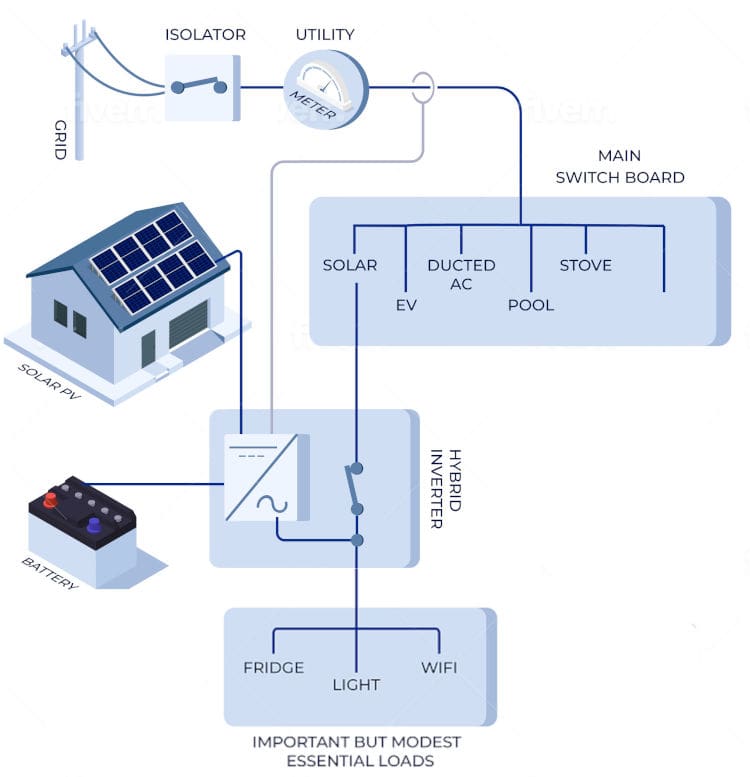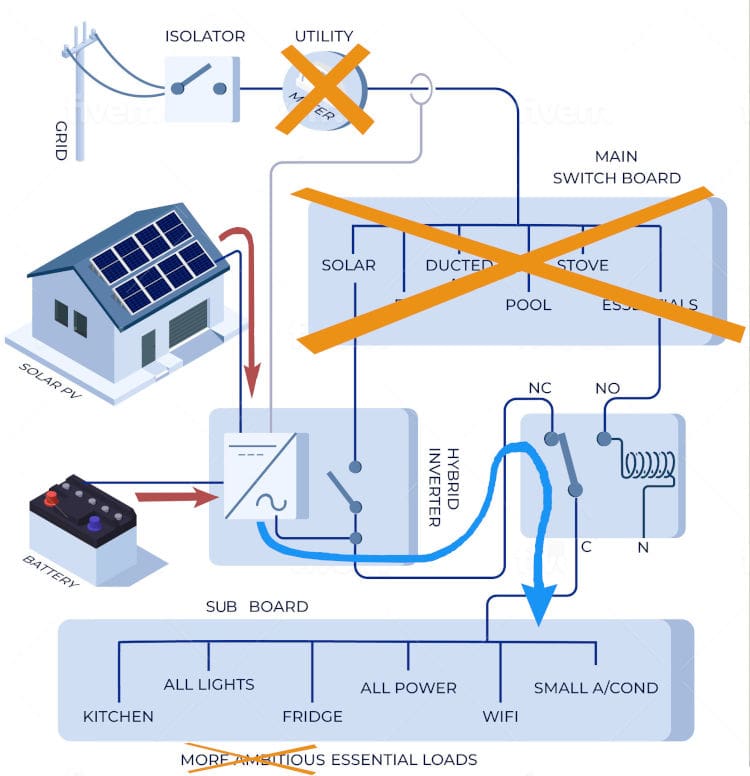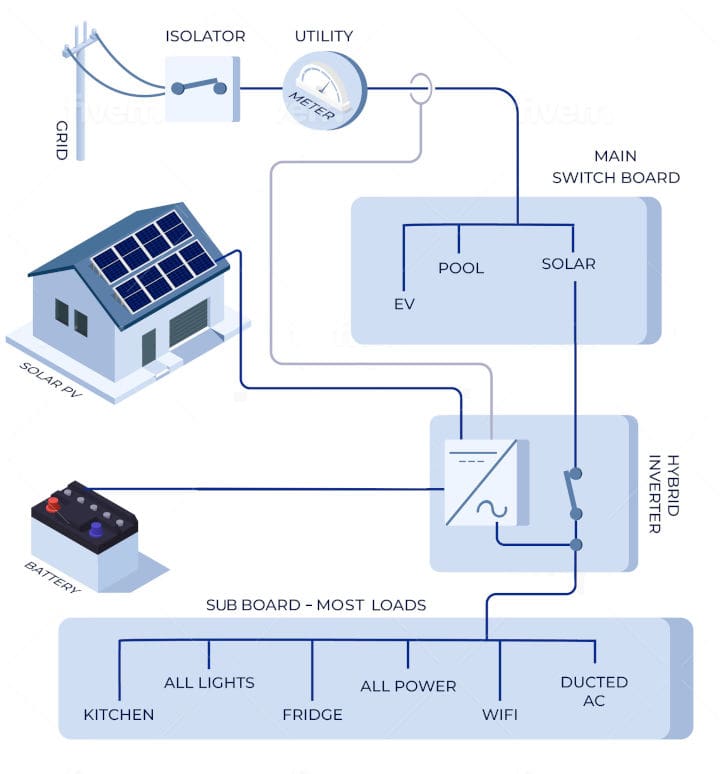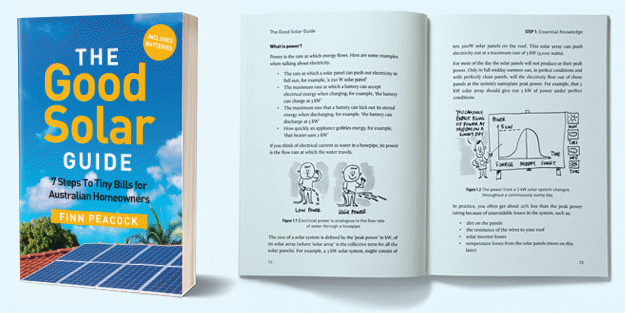![]() Modest hybrid inverters are sometimes oversold by salespeople or romanticised by customers. Their ability to back up your house in a blackout can be limited by capacity and wiring constraints.
Modest hybrid inverters are sometimes oversold by salespeople or romanticised by customers. Their ability to back up your house in a blackout can be limited by capacity and wiring constraints.
If you have awkward house wiring and an older, smaller, cheaper hybrid, we may have an answer to get you backup throughout the house.
So You Bought A Battery System
Sungrow, GoodWe, Solax, Redback, Alpha, SoFar and many others offer what we call a series-connected lightweight hybrid inverter.
Properly installed they’ll offer free solar energy, lower bills and modest blackout protection for a modest price, though not all hybrids offer this without an optional “backup box” and extra wiring.
The key detail to remember is series means the essential circuits are connected to a dedicated port on the inverter.
The backup power runs through the inverter.
Usually one power circuit to run the fridge, internet and phone charger is all that they will cope with, plus your lights.
Where complaints arise, it’s because a small hybrid will only offer around 15 or 27 amps backup capacity (3 to 6kW at a surge).

This is a standard series hybrid arrangement. The backup port should technically power circuits in a sub board that’s segregated from the normal switchboard.
You can’t run more than 27 amps through the inverter, so it’s a choke point even if the grid is available. A responsible electrician simply won’t hook up too many circuits.
Other makers offer parallel connected hybrids, which use a gateway or contactor to disconnect the grid at the main switchboard. So if you buy Fronius, iStore, SolarEdge, Sigen or Tesla, the information in this article doesn’t apply.
Introducing The Bypass Contactor
In your kitchen, the fridge is likely to be sharing a circuit with the kettle, toaster and microwave, but any two of these would overload a small hybrid.
The answer is to bypass the inverter while the grid is available and automatically connect the circuits you want if there’s an outage. For this we use an electrically operated switch, a relay or a contactor in electrical jargon.

Under normal mains powered conditions, more current can be carried through the contactor. There’s no load on the backup port.
Who Needs A Heart Bypass
Solar Quotes always insist that if you install a series hybrid, it must have a manual bypass switch.
If the inverter has a heart attack, anyone can switch the fridge and lights back onto mains power.
In fact, if you buy a Sungrow they’re now a standard inclusion.

Many installers put 5kW inverters on a 32 amp circuit without realising they need almost double the capacity.
How Does A Contactor Help?
Firstly it can be installed instead of the bypass switch, simplifying things for the technologically challenged.
For those with sprawling 3-phase houses or homes supplied from a subcircuit downstream from the shed, running a separate backup circuit can be impractical or cost prohibitive. Using a contactor can physically connect more things to the backup circuit.
There is an obvious risk you will overload the inverter, causing it to trip off temporarily (or just give up and require a manual reset) but having some basic level of power available means maybe the electric roller door will work, the freezer will stay frozen and if you manage it carefully the lights will stay on too.

When the mains goes missing, the contactor is de-energised and springs shut to connect the backup port to the loads. From then on you’ll have to choose things to switch off manually.
Document What You Want Backed Up
For most people, a lightweight grid hybrid system is a perfectly good way to offer some protection from mains outages, but they’re not as good as the grid.
However as an electrician I’ve had a few awkward conversations with people who’ve bought the hype so to speak, only to be disappointed with the reality of a cheap battery system. Early models were all relatively small but that didn’t stop salespeople and customers alike imagining big things for them.
I was once browbeaten by customers who insisted they have lights, fridge, freezer, plus CPAP breathing equipment in the bedroom, all backed up. It ended up with nearly half the house on a weedy little 3kW inverter.
While it coped when the grid was good, frankly it was a recipe for disaster during an outage. All I could do was warn the end users that if they were very careful it might work in a blackout.
Though the kettle was out of bounds, the lights and CPAP machine wouldn’t be on at the same time, and hopefully the fridge and freezer took turns.
New Models Are More Capable
These days there are a variety 8 and 10kW single phase machines that are pretty gutsy contenders. They’re marketed for and genuinely capable of “whole home” blackout protection with only a few exceptions.
There are also 3 phase hybrids available but to single out Sungrow as an example, the 10kW 3ph units are very limited compared to the newer 15/20/25kW models.

“Whole Home” hybrids simplify wiring because they’re rated to pass through 63 amps (14.5kW) so you could put everything through them with 10kW of backup. For this diagram we’ve left the heaviest consumers out.
Back Up 3 Phases With One
It’s not unusual to have a large 3 phase solar power system and a single phase battery hybrid. For some premises it’s difficult to segregate the circuits you want backed up, however a good electrician can use a combination of contactors to both isolate 3 phase appliances and bridge the remaining single phase circuits together to the backup supply.
Solar Edge offers this option straight out of the box; however, any reasonable electrician can arrange it with off-the-shelf components.
A Prime Recommendation
If you want a truly resilient power supply, that needs no internet and lets you treat the grid with contempt, this article isn’t it. We’ll soon have an update of what a durable, heavy duty system looks like.
Electricians Make Magic, Not Miracles
If you consider a 400 watt fridge motor might pull 3000 watts at the instant it starts, a small hybrid may have no spare capacity to run your lights. While this contactor arrangement won’t improve the backup capacity of your inverter, it might make better use of your system without having to rewire the house or dig up the garden to run cables.
If you need some work done on your switchboard, click here and enter a few details. There’s room at the end to add some notes, request a site visit and get some quotes.
And don’t forget your hot water, it’s the cheapest battery you buy.

 RSS - Posts
RSS - Posts



The other consideration is V2G EVs (Electric Vehicles). If I were designing the wiring circuit for a new or upgraded house, I would design in this capability.
One thing I would like EV manufacturers to enable is bi-directional V2H. This also might be possible for non Australian approved V2G vehicles. What I envisage here is a circuit that can be isolated from the grid when the power grid is n/a, but allows the EV V2H connection to supply essential loads, but also soak up excess PV generation. nb Current V2H is only as a supply, not bi-directional.
I like the concept of using C/O Contactors instead of manual switches. This would enable the system to automatically change to off grid setup if the grid goes down. In my case I would not have needed the myriad extension cables when Alfred sent our grid power down. (We ran 5 fridges & comms devices inc computers off a 5kw generator because my battery had depleted (12Kw). A V2H EV would have been nice! (n/a on our old Kona EV)
Hi Doug,
You’re aware of the HOEM device aren’t you? Saves a lot of faffing about with cords & makes it convenient to use every night.
https://www.solarquotes.com.au/blog/hoem-review/
If it wasn’t banned on the WA Shonky Westralian Inadequate Stuff-up Grid something like the single phase Sungrow SH10RS inverter has “Whole home backup available” –
“Backup data ( on grid mode )
Rated output power for backup load 14500 W
Rated output current for backup load 63 A”
and
“Recommended max. PV input power 20000 Wp”
and, as I have previously advised Solar Quotes, Sigenergy now has, approved by the CEC, single phase hybrid inverters with up to 12kW capacity, for whole of home backup, and, driving up to 48kWh of BESS.
But, on the WA Shonky Westralian Inadequate Stuff-up Grid, the only grid in mainland Australia, single phase PV inverters are limited to 5kW capacity, as punishment for householders having household rooftop PV systems.
Oh, and, we have a single phase 5kW hybrid inverter providing whole of home backup (excluding the Solar Hot Water System booster element and the bore pump), and, it mostly works okay (although,. we ARE limited to 5kW of total load for the house, in this primitive state that is WA, with the Shonky Westralian Inadequate Stuff-up Grid).
And, of course, on the Shonky Westralian Inadequate Stuff-up Grid it is illegal to charge a BEV from a single phase household rooftop PV system, limited to 5kW capacity for the household…
This IS WA, with the Shonky Westralian Inadequate Stuff-up Grid.
Hi Brett,
I think you should look at a Selectronic SpPro for your hybrid system.
You can then DC coupled as much solar as you like.
And you’ll have an Australian made product, with 10 years warranty and surge capacity to deliver 12kW AC for 30 seconds.
https://www.solarquotes.com.au/blog/selectronic-sp-pro/
Hi Anthony, in the last (whole home) diagram, for a 3 phase system, the 63A bypass would be 63A per phase wouldn’t it?
Cheers
T
Yes, decent backup capability was paramount when i put my system in last year.
I still have to be careful, as my house basically only has two circuits for powerpoints and i needed them both on the backup, because one has my kitchen, modem and fridge, the other has my freezer and home sewage treatment plant. So I pretty much ended up with everything except the stove and hotplates on backup.
But it all ran smooth as clockwork during Cyclone Alfred, I used a generator to to cook with (electric frypan, air fryer, jug etc) to minimise load on the battery, and the battery didn’t get below 40% in the two days we were without power.
Anthony I sympathise. Some customers don’t understand the difference between what is technically possible and practical reality. We should bear in mind that when the ‘average’ consumer uses the back-up system with a battery it is just that and perhaps it is prudent to be limited to essential circuits so that the most can be made of whatever system/battery you have.
With severe weather outages I believe an understanding of power consumption versus what you have is essential and some people unreasonably “just want it to work” as you say.
We have a 10 kWh ESS battery with hybrid inverter, 20 Sunpower P19 325w panels 5 years old, UPS instant automatic changeover, this computer notices but nothing else.
Sadly when the UPS set-up was configured we forgot that in adverse weather conditions or indeed in winter we need to boost our solar hot water for an hour or so. Cyclone Alfred was kind enough to point that out to me !
Good article.
One issue we had when looking at battery and capacity to service house and appliances was lack of info re appliances.
What I mean is our newish LG fridge /freezer had very limited info re wattage, power use and no info re start up load. LG Technical were useless and no info online or in any manuals. So far there is virtually no data from manuf as to their appliance start load or running load when cycling on/off.
Maybe along with the energy sticker on the front there should be accurate load data to the combined house loads could be estimated.
I have a goodwe et15. I have yet to decide on a battery. Reading the battery specs, it would seem that most hybrid inverters are limited by the output capacity of the battery itself.
Ie a 6kwh battery will not be able to output 10kw despite the 10kw hybrid inverter.
How does one isolate the 3 phase devices using contactors?
Hi Techno
I have come to the realisation that you can’t rely on others to do the right thing or have the knowledge needed by customers about their own products.
In your case, l would use a plugin energy meter ( cost around $50) to measure energy used on start up and running.
From what I’ve seen, the Selectronics are nice units, but they are more than three times the price of Victron inverters. In aussie dollars it’s over $8k for a 7.5KW Selectronics vs $2.2K for a 10KW Victron Multiplus II. It’s true that only the 3KW and 5KW Victron models are CEC approved, but if you want CEC-approved 10KW you can simply use 2 x Victron 5KW models in Parallel at about the same price but with greater redundancy and flexibility.
Hi Layton,
Selectronic have brilliant local support and locally hosted web monitoring, along with 10 year warranty and 240% surge rating.
The thing about victron is that you need a 10kW unit to be comparable capacity to a 7.5kW SpPro.
Having Victron in parallel only gives you redundancy if you’re savvy enough to physically disconnect & technically reconfigure the system.
Victron make fine devices with very good monitoring, but
When there’s a problem with your system, either you have an internet forum to refer to, or the wholesaler provides support, if they know how to solve the issues.
However, if they go out of business, the next Victron distributor isn’t likely to help.
There is no Victron Australia to phone if you have a problem.
Do you have or can write an article for a
best suggestion for another “Alfred” to supply some type of battery backup using AC coupling?
Assumption is for at least a 13 kw rooftop panels with existing 10kw Sungrow inverter.
With either auto or manual switch o er when the grid fails again for 4 days!
Thanks.
Hi Marty,
I would look at a new Sungrow hybrid (plus more solar) and use your existing system downstream of the new unit on the backup side.
Effectively you can AC couple your system with many different hybrids, but staying with one brand simplifies the monitoring and control.
Add gas instantaneous hot water service to the list of essential household loads – for those of us who would miss a warm shower during a power outage.
I wonder if they make a mains powered instantaneous gas hws with battery backup, simply to alarm systems
You could probably have an instant HWS that uses mains to control it and have a standalone UPS such as people use for computers if you don’t have a battery with UPS provision. They don’t use much power from memory and as you say elsewhere you can measure the power consumption before you spend any money. I had one such HWS in north QLD but in that case once the generator was going everything was ‘normal’.
For example I run a dog containment system on 20w of 12v solar panels, a small inverter and an old 4WD battery and at the gate an automatic opener also on 120w panels and old small car battery but that system is 12v. Both have charge controllers and have been working for years and gets a ‘second life’ from the batteries.
We lost power for five days during the recent cyclone, and our Sungrow SH10RS inverter and 10KWh battery worked flawlessly as it was, however the issue that took me totally by surprise was the extreme lack of sunlight during the event. It wouldn’t have mattered what inverter or battery we had, because our solar generation dropped to around 3% of normal for three days straight, and the fourth day it was only about 10%/ We were making about 1KWh per day from 7KW of solar for three days. That’s not enough to run a fridge for 24 hours, let alone anything else.
Hi Lachlan,
This is why we advise everyone should fill their roof.
Systems sized for winter are the new black.
Hi Anthony,
Yes we’re doing that right now. We’re adding another 7.5KW, which is as much as we can fit on the rest of the roof. It still wouldn’t have made a lot of difference during those few days of the cyclone though.
The length of outages during these weather events is disappointing though. It’s the second time in 14 months that we’ve gone 5 days without power, and we live in a central suburb with 100% underground power. The nearest overhead lines are 2-3km away.
I think that if you want guaranteed power during these events, a generator is the only option. Either that or look for a small wind turbine. If we’d had one of those we would have been laughing!
Hi Lachlan,
After 15 years doing remote area power I assure you it’s the generator that always made my phone ring. If you’re off grid they’re essential but equally a curse.
And wind turbines are the things most likely to be wrecked in a storm.
I’ve seen the aftermath when turbine blades are spat through the roof of a rainwater tank or driven 600mm into the ground.
People are fascinated to have a whirligig in the yard but solar is so cheap now nobody installs wind.
Really resilient power comes with a system designed for off grid service.
A lightweight grid hybrid isn’t the answer.
https://www.solarquotes.com.au/blog/selectronic-sp-pro/
In the 1950s my father installed a windmill generator to augment our 32v system. I was born after this, by which time it was a tangled mess on the ground so I second the idea to just have more solar. During Alfred our little house ran for 4 days okay (no HW) with 3kva Victron + batteries offgrid system. The 800w of panels surprisingly still made some power in grey rainy weather…not much but enough to keep a few lights on if it had been needed.
Hi Owen,
The old Dunlite “freelight” units were pretty durable. I have a slightly mangled 4 blade one as a wall hanger, but as we often advised people, if you have a really viable site for a wind turbine, it’s not somewhere you’d want to live.
Glad to hear your system worked ok. 800w of panels is tiny these days. How much battery do you have?
The 800w is just completely separate offgrid I use often but house had 6kw grid connected PV. I also have another 400w panel as roof to my electric motorcycle parking, with cheap lifepo4 24v 80Ah battery which charges the motorcycle offgrid. I have about 5kwh of batteries with the victron 12v inverter. I grew up 12 miles from Brisbane GPO without mains power until 1969. Dad had made a rotary converter 32to240 back in the day to run the TV 🙂 Modern inverters are way more efficient !
Lachlan, we are in Beenleigh and are set up for outages of over a week with no drama.
What we do is run the house essentials like the fridge, lights, sewing machine, computers, dishwasher and washing machine on the generator during the day until the battery gets as full as it can for the night so whatever the panels offer is stored then we have a peaceful night. It’s a bit fiddly and only a short term thing.
The large power use items are used one at time as it is only a 2500 w inverter generator but that works for us and it is very economical. There is a Brisbane region vendor that offers 2 such generators in parallel for less than a 5kWh unit would cost that might be a better option if you are on a budget and need more power/flexibility.
When I lived in Proserpine we did not have a battery but 20 panels and manual changeover for an 8kWh Honda knock off generator that basically made things “normal”, bigger is always better. Long outages can be a fact of life up there in summer. That was set up as “one or the other” no solar power if the mains were out but it was a while ago, things are different now.
Hope that helps, not sure if it is kosher to share the name of the generator vendor in these messages, someone please tell me ?
I have a goodwe et15. I have yet to decide on a battery. Reading the battery specs, it would seem that most hybrid inverters are limited by the output capacity of the battery itself.
Ie a 6kwh battery will not be able to output 10kw despite the 10kw hybrid inverter.
How does one isolate the 3 phase devices using contactors?
So many people think that a battery backup system will allow them to operate nearly every appliance in the home during an outage over several days.
We have a growatt 5kva hybrid inverter, 4.8kw of solar and 10kwh of battery.
This system runs most of the house most of the time but in an outage we restrict ourselves to lights, fridge, fans and power to recharge phones and tablets.
We have a gas stove and solar hws which we heat manually for an hour each day if it is winter or cloudy.
If you were to ask me what is the number one most essential thing, it would be the fridge.
When it comes time to replace it, look not only for the most energy efficient but for the correct size for your needs.
Plan for the worst but hope for the best
I have two Growatt sph5000tl hub inverters each with own battery (ALP), installed about two months ago.
I learned the hard way the circuits connected to EPS (the backup power) of the inverter cannot exceed inverters capacity which is 5kw in my case even while still running on grid. The installer seems to have idea and initially offered whole house to be wired to EPS output. In my kitchen, just a toaster, kettle and microwave, plus background load of 800W can exceed 5kw. I am considering contactor wired in such that under normal grid operation all circuits would run on normal AC output of the inverters which in case of insufficient capacity can be topped up from the grid and if the grid does down some circuits would switch to run from EPS output of the inverter. As shown on these diagrams. https://www.alternergy.co.uk/media/mageplaza/product_attachments/attachment_file/g/r/growatt_sph_3000-6000_eps_wiring_guide_type_a_-_18_04_2018.pdf
Hi Mark,
Most 5kW hybrids will cope with 6kW as a surge for 10 seconds.
Are you finding the Growatt will do 5kW and nothing more?
It appears from the diagram that the unit you have would be programmed to energise the EPS circuit and pull the contactor in when the mains power fails.
We have an example here that does the same thing for an inverter that has continuous output at the EPS port.
The changeover contactor here drops out with the mains power, which connects the EPS to your essential loads via NC contacts.
Anthony,
EPS AC output might handle more than 5kw, I have not measured how much exactly. I will get my own electrician to wire in the contactor. I wonder why Growatt designed it like that.
We almost had this issue with our inverter, but our installer wisely switched to a larger 10KW Sungrow inverter. This means we can safely run the whole house off the backup circuit, including our very large ducted aircon system, without any issues. Well, four years and no issues yet lol
Now our only problem is that we’re locked into ridiculously overpriced Sungrow battery modules. I got two quotes from two very large installers for upgrading our battery from 10kw to 20kw about 18 months ago, before the battery rebate was announced. It was too much so I put it on the backburner. When I asked for those quotes to be updated about a month ago, what a surprise, the price had gone up almost enough to eat the entire rebate.
Meanwhile you can now get a complete 30KW battery for significantly less than the price of upgrading ours by 10kw.
David, we are almost identical, perhaps try a smart switch for the hot water booster so that in winter it is programmed to be always on for an hour after the house battery is charged 1230 -1330 seems to work when any solar output is likely to be at maximum and possibly exporting or in our case throttled as well.
“one most essential thing, it would be the fridge. ” and on tank water only the water pump !
Our 2400w inverter generator that we have had for 9 years is currently on special around $850 with 2 years warranty which in my view is ‘cheap insurance’.
I take care to empty the fuel tank after use, clean the air filter and change the oil regularly it is seldom used for anything else and is quite possibly better looked after than the mower. Fresh fuel and full jerry cans when storms are coming is SOP.